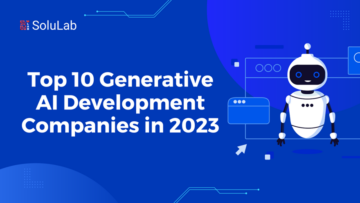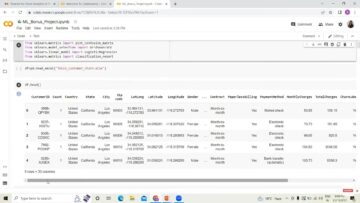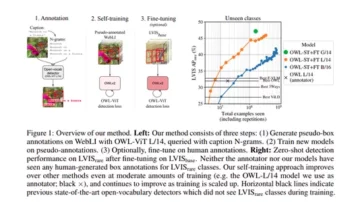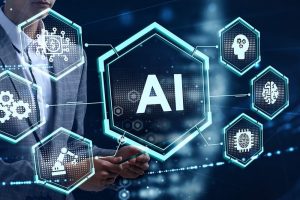Introduction
The rapid advancements in Large Language Models (LLMs) have transformed the landscape of AI, offering unparalleled capabilities in natural language understanding and generation. LLMs have ushered in a new language understanding and generation era, with OpenAI’s GPT models at the forefront. These remarkable models honed on extensive online data, have broadened our horizons, enabling us to interact with AI-powered systems like never before. However, like any technological marvel, they come with their own set of limitations. One glaring issue is their occasional tendency to provide information that is either inaccurate or outdated. Moreover, these LLMs do not furnish the sources of their responses, making it challenging to verify the reliability of their output. This limitation becomes especially critical in contexts where accuracy and traceability are paramount. Retrieval Augmented Generation (RAG) in AI is a transformative paradigm that promises to revolutionize the capabilities of LLMs.
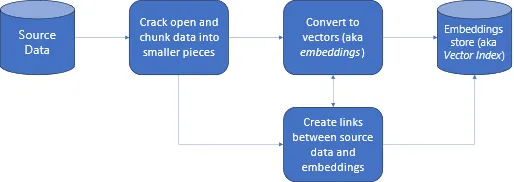
Rapid advancements in LLMs have propelled them to the forefront of AI, yet they still grapple with constraints like information capacity and occasional inaccuracies. RAG bridges these gaps by seamlessly integrating retrieval-based and generative components, endowing LLMs to tap into external knowledge sources. This article explores RAG’s profound impact, unraveling its architecture, benefits, challenges, and the diverse approaches that empower it. In doing so, we unveil the potential of RAG to redefine the landscape of Large Language Models and pave the way for more accurate, context-aware, and reliable AI-driven communication.
Learning Objectives
- Learn about language models and how RAG enhances their capabilities.
- Discover methods to integrate external data into RAG systems effectively.
- Explore ethical issues in RAG, including bias and privacy.
- Gain hands-on experience with RAG using LangChain for real-world applications.
This article was published as a part of the Data Science Blogathon.
Table of contents
Understanding Retrieval Augmented Generation (RAG)
Retrieval Augmented Generation, or RAG, represents a cutting-edge approach to artificial intelligence (AI) and natural language processing (NLP). At its core, RAG is an innovative framework that combines the strengths of retrieval-based and generative models, revolutionizing how AI systems understand and generate human-like text.
The Fusion of Retrieval-Based and Generative Models
RAG is fundamentally a hybrid model that seamlessly integrates two critical components. Retrieval-based methods involve accessing and extracting information from external knowledge sources such as databases, articles, or websites. On the other hand, generative models excel in generating coherent and contextually relevant text. What distinguishes RAG is its ability to harmonize these two components, creating a symbiotic relationship that allows it to comprehend user queries deeply and produce responses that are not just accurate but also contextually rich.
The Need for RAG
The development of RAG is a direct response to the limitations of Large Language Models (LLMs) like GPT. While LLMs have shown impressive text generation capabilities, they often struggle to provide contextually relevant responses, hindering their utility in practical applications. RAG aims to bridge this gap by offering a solution that excels in understanding user intent and delivering meaningful and context-aware replies.
Deconstructing RAG’s Mechanics
To grasp the essence of RAG, it’s essential to deconstruct its operational mechanics. RAG operates through a series of well-defined steps. It begins by processing user input and parsing it for meaning and intent. It then leverages retrieval-based methods to access external knowledge sources, enriching its understanding of the user’s query. Finally, RAG employs its generative capabilities to produce factually accurate, contextually relevant, and coherent responses. This step-by-step process ensures that RAG can transform user queries into meaningful, human-like responses.
The Role of Language Models and User Input
Central to understanding RAG is appreciating the role of Large Language Models (LLMs) in AI systems. LLMs like GPT are the backbone of many NLP applications, including chatbots and virtual assistants. They excel in processing user input and generating text, but their accuracy and contextual awareness are paramount for successful interactions. RAG strives to enhance these essential aspects through its integration of retrieval and generation.
Incorporating External Knowledge Sources
RAG’s distinguishing feature is its ability to integrate external knowledge sources seamlessly. By drawing from vast information repositories, RAG augments its understanding, enabling it to provide well-informed and contextually nuanced responses. Incorporating external knowledge elevates the quality of interactions and ensures that users receive relevant and accurate information.
Generating Contextual Responses
Ultimately, the hallmark of RAG is its ability to generate contextual responses. It considers the broader context of user queries, leverages external knowledge, and produces responses demonstrating a deep understanding of the user’s needs. These context-aware responses are a significant advancement, as they facilitate more natural and human-like interactions, making AI systems powered by RAG highly effective in various domains.
Retrieval Augmented Generation (RAG) is a transformative concept in AI and NLP. By harmonizing retrieval and generation components, RAG addresses the limitations of existing language models and paves the way for more intelligent and context-aware AI interactions. Its ability to seamlessly integrate external knowledge sources and generate responses that align with user intent positions RAG as a game-changer in developing AI systems that can truly understand and communicate with users in a human-like manner.
The Power of External Data
In this section, we delve into the pivotal role of external data sources within the Retrieval Augmented Generation (RAG) framework. We explore the diverse range of data sources that can be harnessed to empower RAG-driven models.

APIs and Real-time Databases
APIs (Application Programming Interfaces) and real-time databases are dynamic sources that provide up-to-the-minute information to RAG-driven models. They allow models to access the latest data as it becomes available.
Document Repositories
Document repositories serve as valuable knowledge stores, offering structured and unstructured information. They are fundamental in expanding the knowledge base that RAG models can draw upon.
Webpages and Scraping
Web scraping is a method for extracting information from web pages. It enables RAG models to access dynamic web content, making it a crucial source for real-time data retrieval.
Databases and Structured Information
Databases provide structured data that can be queried and extracted. RAG models can use databases to retrieve specific information, enhancing the accuracy of their responses.
Benefits of Retrieval Augmented Generation (RAG)
Enhanced LLM Memory
RAG addresses the information capacity limitation of traditional Language Models (LLMs). Traditional LLMs have a limited memory called “Parametric memory.” RAG introduces a “Non-Parametric memory” by tapping into external knowledge sources. This significantly expands the knowledge base of LLMs, enabling them to provide more comprehensive and accurate responses.
Improved Contextualization
RAG enhances the contextual understanding of LLMs by retrieving and integrating relevant contextual documents. This empowers the model to generate responses that align seamlessly with the specific context of the user’s input, resulting in accurate and contextually appropriate outputs.
Updatable Memory
A standout advantage of RAG is its ability to accommodate real-time updates and fresh sources without extensive model retraining. This keeps the external knowledge base current and ensures that LLM-generated responses are always based on the latest and most relevant information.
Source Citations
RAG-equipped models can provide sources for their responses, enhancing transparency and credibility. Users can access the sources that inform the LLM’s responses, promoting transparency and trust in AI-generated content.
Reduced Hallucinations
Studies have shown that RAG models exhibit fewer hallucinations and higher response accuracy. They are also less likely to leak sensitive information. Reduced hallucinations and increased accuracy make RAG models more reliable in generating content.
These benefits collectively make Retrieval Augmented Generation (RAG) a transformative framework in Natural Language Processing, overcoming the limitations of traditional language models and enhancing the capabilities of AI-powered applications.
Diverse Approaches in RAG
RAG offers a spectrum of approaches for the retrieval mechanism, catering to various needs and scenarios:
- Simple: Retrieve relevant documents and seamlessly incorporate them into the generation process, ensuring comprehensive responses.
- Map Reduce: Combine responses generated individually for each document to craft the final response, synthesizing insights from multiple sources.
- Map Refine: Iteratively refine responses using initial and subsequent documents, enhancing response quality through continuous improvement.
- Map Rerank: Rank responses and select the highest-ranked response as the final answer, prioritizing accuracy and relevance.
- Filtering: Apply advanced models to filter documents, utilizing the refined set as context for generating more focused and contextually relevant responses.
- Contextual Compression: Extract pertinent snippets from documents, generating concise and informative responses and minimizing information overload.
- Summary-Based Index: Leverage document summaries, index document snippets, and generate responses using relevant summaries and snippets, ensuring concise yet informative answers.
- Forward-Looking Active Retrieval Augmented Generation (FLARE): Predict forthcoming sentences by initially retrieving relevant documents and iteratively refining responses. Flare ensures a dynamic and contextually aligned generation process.
These diverse approaches empower RAG to adapt to various use cases and retrieval scenarios, allowing for tailored solutions that maximize AI-generated responses’ relevance, accuracy, and efficiency.
Ethical Considerations in RAG
RAG introduces ethical considerations that demand careful attention:
- Ensuring Fair and Responsible Use: Ethical deployment of RAG involves using the technology responsibly and refraining from any misuse or harmful applications. Developers and users must adhere to ethical guidelines to maintain the integrity of AI-generated content.
- Addressing Privacy Concerns: RAG’s reliance on external data sources may involve accessing user data or sensitive information. Establishing robust privacy safeguards to protect individuals’ data and ensure compliance with privacy regulations is imperative.
- Mitigating Biases in External Data Sources: External data sources can inherit biases in their content or collection methods. Developers must implement mechanisms to identify and rectify biases, ensuring AI-generated responses remain unbiased and fair. This involves constant monitoring and refinement of data sources and training processes.
Applications of Retrieval Augmented Generation (RAG)
RAG finds versatile applications across various domains, enhancing AI capabilities in different contexts:
- Chatbots and AI Assistants: RAG-powered systems excel in question-answering scenarios, providing context-aware and detailed answers from extensive knowledge bases. These systems enable more informative and engaging interactions with users.
- Education Tools: RAG can significantly improve educational tools by offering students access to answers, explanations, and additional context based on textbooks and reference materials. This facilitates more effective learning and comprehension.
- Legal Research and Document Review: Legal professionals can leverage RAG models to streamline document review processes and conduct efficient legal research. RAG assists in summarizing statutes, case law, and other legal documents, saving time and improving accuracy.
- Medical Diagnosis and Healthcare: In the healthcare domain, RAG models serve as valuable tools for doctors and medical professionals. They provide access to the latest medical literature and clinical guidelines, aiding in accurate diagnosis and treatment recommendations.
- Language Translation with Context: RAG enhances language translation tasks by considering the context in knowledge bases. This approach results in more accurate translations, accounting for specific terminology and domain knowledge, particularly valuable in technical or specialized fields.
These applications highlight how RAG’s integration of external knowledge sources empowers AI systems to excel in various domains, providing context-aware, accurate, and valuable insights and responses.
The Future of RAGs and LLMs
The evolution of Retrieval-Augmented Generation (RAG) and Large Language Models (LLMs) is poised for exciting developments:
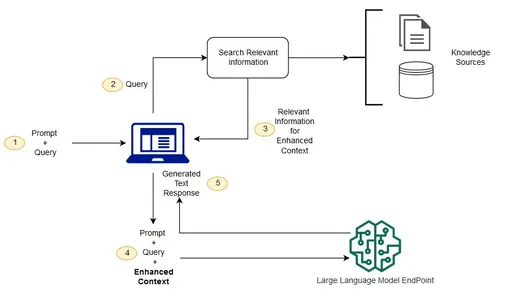
- Advancements in Retrieval Mechanisms: The future of RAG will witness refinements in retrieval mechanisms. These enhancements will focus on improving the precision and efficiency of document retrieval, ensuring that LLMs access the most relevant information quickly. Advanced algorithms and AI techniques will play a pivotal role in this evolution.
- Integration with Multimodal AI: The synergy between RAG and multimodal AI, which combines text with other data types like images and videos, holds immense promise. Future RAG models will seamlessly incorporate multimodal data to provide richer and more contextually aware responses. This will open doors to innovative applications like content generation, recommendation systems, and virtual assistants.
- RAG in Industry-Specific Applications: As RAG matures, it will find its way into industry-specific applications. Healthcare, law, finance, and education sectors will harness RAG-powered LLMs for specialized tasks. For example, in healthcare, RAG models will aid in diagnosing medical conditions by instantly retrieving the latest clinical guidelines and research papers, ensuring doctors have access to the most current information.
- Ongoing Research and Innovation in RAG: The future of RAG is marked by relentless research and innovation. AI researchers will continue to push the boundaries of what RAG can achieve, exploring novel architectures, training methodologies, and applications. This ongoing pursuit of excellence will result in more accurate, efficient, and versatile RAG models.
- LLMs with Enhanced Retrieval Capabilities: LLMs will evolve to possess enhanced retrieval capabilities as a core feature. They will seamlessly integrate retrieval and generation components, making them more efficient at accessing external knowledge sources. This integration will lead to LLMs that are proficient in understanding context and excel in providing context-aware responses.
Utilizing LangChain for Enhanced Retrieval-Augmented Generation (RAG)
Installation of LangChain and OpenAI Libraries
This line of code installs the LangChain and OpenAI libraries. LangChain is critical for handling text data and embedding, while OpenAI provides access to state-of-the-art Large Language Models (LLMs). This installation step is essential for setting up the required tools for RAG.
!pip install langchain openai
!pip install -q -U faiss-cpu tiktokenimport os
import getpass os.environ["OPENAI_API_KEY"] = getpass.getpass("Open AI API Key:")Web Data Loading for the RAG Knowledge Base
- The code utilizes LangChain’s “WebBaseLoader.”
- Three web pages are specified for data retrieval: YOLO-NAS object detection, DeciCoder’s code generation efficiency, and a Deep Learning Daily newsletter.
- This step is essential for building the knowledge base used in RAG, enabling contextually relevant and accurate information retrieval and integration into language model responses.
from langchain.document_loaders import WebBaseLoader yolo_nas_loader = WebBaseLoader("https://deci.ai/blog/yolo-nas-object-detection-foundation-model/").load() decicoder_loader = WebBaseLoader("https://deci.ai/blog/decicoder-efficient-and-accurate-code-generation-llm/#:~:text=DeciCoder's%20unmatched%20throughput%20and%20low,re%20obsessed%20with%20AI%20efficiency.").load() yolo_newsletter_loader = WebBaseLoader("https://deeplearningdaily.substack.com/p/unleashing-the-power-of-yolo-nas").load()Embedding and Vector Store Setup
- The code sets up embeddings for the RAG process.
- It uses “OpenAIEmbeddings” to create an embedding model.
- A “CacheBackedEmbeddings” object is initialized, allowing embeddings to be stored and retrieved efficiently using a local file store.
- A “FAISS” vector store is created from the preprocessed chunks of web data (yolo_nas_chunks, decicoder_chunks, and yolo_newsletter_chunks), enabling fast and accurate similarity-based retrieval.
- Finally, a retriever is instantiated from the vector store, facilitating efficient document retrieval during the RAG process.
from langchain.embeddings.openai import OpenAIEmbeddings
from langchain.embeddings import CacheBackedEmbeddings
from langchain.vectorstores import FAISS
from langchain.storage import LocalFileStore store = LocalFileStore("./cachce/") # create an embedder
core_embeddings_model = OpenAIEmbeddings() embedder = CacheBackedEmbeddings.from_bytes_store( core_embeddings_model, store, namespace = core_embeddings_model.model
) # store embeddings in vector store
vectorstore = FAISS.from_documents(yolo_nas_chunks, embedder) vectorstore.add_documents(decicoder_chunks) vectorstore.add_documents(yolo_newsletter_chunks) # instantiate a retriever
retriever = vectorstore.as_retriever()Establishing the Retrieval System
- The code configures the retrieval system for Retrieval Augmented Generation (RAG).
- It uses “OpenAIChat” from the LangChain library to set up a chat-based Large Language Model (LLM).
- A callback handler named “StdOutCallbackHandler” is defined to manage interactions with the retrieval system.
- The “RetrievalQA” chain is created, incorporating the LLM, retriever (previously initialized), and callback handler.
- This chain is designed to perform retrieval-based question-answering tasks, and it is configured to return source documents for added context during the RAG process.
from langchain.llms.openai import OpenAIChat
from langchain.chains import RetrievalQA
from langchain.callbacks import StdOutCallbackHandlerllm = OpenAIChat()
handler = StdOutCallbackHandler()# This is the entire retrieval system
qa_with_sources_chain = RetrievalQA.from_chain_type( llm=llm, retriever=retriever, callbacks=[handler], return_source_documents=True
)Initializes the RAG System
The code sets up a RetrievalQA chain, a critical part of the RAG system, by combining an OpenAIChat language model (LLM) with a retriever and callback handler.
Issue Queries to the RAG System
It sends various user queries to the RAG system, prompting it to retrieve contextually relevant information.
Retrieves Responses
After processing the queries, the RAG system generates and returns contextually rich and accurate responses. The responses are printed on the console.
# This is the entire augment system!
response = qa_with_sources_chain({"query":"What does Neural Architecture Search have to do with how Deci creates its models?"})responseprint(response['result'])
print(response['source_documents'])response = qa_with_sources_chain({"query":"What is DeciCoder"})print(response['result'])response = qa_with_sources_chain({"query":"What is DeciCoder"})print(response['result'])response = qa_with_sources_chain({"query":"Write a blog about Deci and how it used NAS to generate YOLO-NAS and DeciCoder"})print(response['result'])This code exemplifies how RAG and LangChain can enhance information retrieval and generation in AI applications.
Output
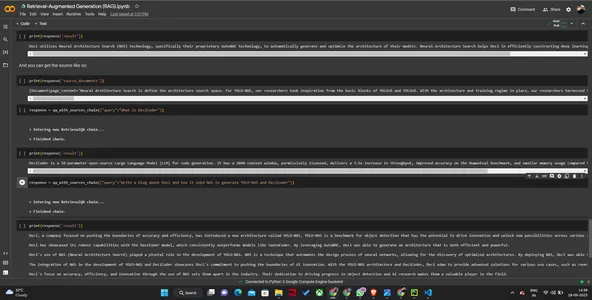
Conclusion
Retrieval Augmented Generation (RAG) represents a transformative leap in artificial intelligence. It seamlessly integrates Large Language Models (LLMs) with external knowledge sources, addressing the limitations of LLMs’ parametric memory.
RAG’s ability to access real-time data, coupled with improved contextualization, enhances the relevance and accuracy of AI-generated responses. Its updatable memory ensures responses are current without extensive model retraining. RAG also offers source citations, bolstering transparency and reducing data leakage. In summary, RAG empowers AI to provide more accurate, context-aware, and reliable information, promising a brighter future for AI applications across industries.
Key Takeaways
- Retrieval Augmented Generation (RAG) is a groundbreaking framework that enhances Large Language Models (LLMs) by integrating external knowledge sources.
- RAG overcomes the limitations of LLMs’ parametric memory, enabling them to access real-time data, improving contextualization, and providing up-to-date responses.
- With RAG, AI-generated content becomes more accurate, context-aware, and transparent, as it can cite sources and reduce data leakage.
- RAG’s updatable memory eliminates frequent model retraining, making it a cost-effective solution for various applications.
- This technology promises to revolutionize AI across industries, providing users with more reliable and relevant information.
Frequently Asked Questions
A. RAG, or Retrieval Augmented Generation, is an innovative AI framework combining retrieval-based and generative models’ strengths. Unlike traditional AI models, which generate responses solely based on their pre-trained knowledge, RAG integrates external knowledge sources, allowing it to provide more accurate, up-to-date, and contextually relevant responses.
A. RAG employs a retrieval system that fetches information from external sources. It ensures accuracy through techniques like vector similarity search and real-time updates to external datasets. Additionally, RAG allows users to access source citations, enhancing transparency and credibility.
A. Yes, RAG is versatile and can be applied across various domains. It’s particularly useful in fields where accurate and current information is crucial, such as healthcare, finance, legal, and customer support.
A. While RAG involves some technical components, user-friendly tools, and libraries are available to simplify the process. Many organizations are also developing user-friendly RAG platforms, making it accessible to a broader audience.
A. RAG does raise critical ethical considerations. Ensuring the quality and reliability of external data sources, preventing misinformation, and safeguarding user data are ongoing challenges. Ethical guidelines and responsible AI practices are crucial in addressing these concerns.
The media shown in this article is not owned by Analytics Vidhya and is used at the Author’s discretion.
Related
- SEO Powered Content & PR Distribution. Get Amplified Today.
- PlatoData.Network Vertical Generative Ai. Empower Yourself. Access Here.
- PlatoAiStream. Web3 Intelligence. Knowledge Amplified. Access Here.
- PlatoESG. Carbon, CleanTech, Energy, Environment, Solar, Waste Management. Access Here.
- PlatoHealth. Biotech and Clinical Trials Intelligence. Access Here.
- Source: https://www.analyticsvidhya.com/blog/2023/09/unlocking-knowledge-with-retrieval-augmented-generation-rag-in-ai/
- :is
- :not
- :where
- $UP
- 11
- 12
- 14
- 17
- 25
- a
- ability
- About
- access
- accessible
- accessing
- accommodate
- Accounting
- accuracy
- accurate
- Achieve
- across
- active
- adapt
- added
- Additional
- Additionally
- addresses
- addressing
- adhere
- advanced
- advancement
- advancements
- ADvantage
- AI
- AI models
- AI systems
- AI-powered
- Aid
- aims
- algorithms
- align
- aligned
- allow
- Allowing
- allows
- also
- always
- an
- analytics
- Analytics Vidhya
- and
- answer
- answers
- any
- api
- Application
- applications
- applied
- appreciating
- approach
- approaches
- appropriate
- architecture
- ARE
- article
- articles
- artificial
- artificial intelligence
- Artificial intelligence (AI)
- AS
- asked
- aspects
- assistants
- assists
- At
- attention
- audience
- augmented
- available
- aware
- awareness
- Backbone
- base
- based
- BE
- becomes
- before
- benefits
- between
- bias
- biases
- Blog
- boundaries
- BRIDGE
- bridges
- brighter
- broader
- Building
- but
- by
- called
- CAN
- capabilities
- Capacity
- careful
- case
- cases
- chain
- chains
- challenges
- challenging
- chatbots
- Clinical
- code
- COHERENT
- collection
- collectively
- combine
- combines
- combining
- come
- communicate
- Communication
- compliance
- components
- comprehend
- comprehensive
- concept
- Concerns
- concise
- conditions
- Conduct
- configured
- considerations
- considering
- considers
- Console
- constant
- constraints
- content
- context
- contexts
- contextual
- continue
- continuous
- Core
- cost-effective
- coupled
- craft
- create
- created
- creates
- Creating
- Credibility
- critical
- crucial
- Current
- customer
- Customer Support
- cutting-edge
- daily
- data
- data leakage
- data privacy
- databases
- datasets
- deconstruct
- deep
- deep learning
- defined
- delivering
- delve
- Demand
- demonstrating
- deployment
- designed
- detailed
- Detection
- developers
- developing
- Development
- developments
- diagnosing
- diagnosis
- differ
- different
- direct
- discretion
- diverse
- do
- Doctors
- document
- documents
- does
- doing
- domain
- domains
- doors
- draw
- drawing
- during
- dynamic
- each
- Education
- educational
- Effective
- effectively
- efficiency
- efficient
- efficiently
- either
- eliminates
- embedding
- employs
- empower
- empowers
- enable
- enables
- enabling
- engaging
- enhance
- enhanced
- enhancements
- Enhances
- enhancing
- enriching
- ensure
- ensures
- ensuring
- Entire
- Era
- especially
- essence
- essential
- establishing
- Ether (ETH)
- ethical
- evolution
- evolve
- example
- Excel
- Excellence
- exciting
- exemplifies
- exhibit
- existing
- expanding
- expands
- experience
- expertise
- explore
- explores
- Exploring
- extensive
- external
- facilitate
- facilitates
- facilitating
- fair
- FAST
- Feature
- fewer
- Fields
- File
- filter
- final
- Finally
- finance
- Find
- finds
- flare
- Focus
- focused
- For
- forefront
- forthcoming
- Framework
- frequent
- fresh
- from
- fundamental
- fundamentally
- fusion
- future
- game-changer
- gap
- gaps
- generate
- generated
- generates
- generating
- generation
- generative
- grasp
- groundbreaking
- guidelines
- hand
- Handling
- hands-on
- harmful
- harness
- Have
- healthcare
- higher
- Highlight
- highly
- holds
- Horizons
- How
- However
- HTTPS
- Hybrid
- hybrid model
- identify
- images
- immense
- Impact
- imperative
- implement
- implementing
- import
- impressive
- improve
- improved
- improvement
- improving
- in
- inaccurate
- Including
- incorporate
- incorporating
- increased
- index
- Individually
- industries
- industry-specific
- inform
- information
- informative
- initial
- initially
- Innovation
- innovative
- input
- insights
- install
- installation
- instantly
- integrate
- Integrates
- Integrating
- integration
- integrity
- Intelligence
- Intelligent
- intent
- interact
- interactions
- interfaces
- into
- Introduces
- involve
- involves
- issue
- issues
- IT
- ITS
- just
- Key
- knowledge
- landscape
- language
- large
- latest
- Law
- lead
- leak
- Leap
- learning
- Legal
- less
- Leverage
- leverages
- libraries
- Library
- like
- likely
- limitation
- limitations
- Limited
- Line
- literature
- loading
- local
- maintain
- make
- Making
- manage
- manner
- many
- marked
- marvel
- materials
- matures
- Maximize
- May..
- meaning
- meaningful
- mechanics
- mechanism
- mechanisms
- Media
- medical
- Memory
- method
- methodologies
- methods
- minimizing
- Misinformation
- misuse
- model
- models
- monitoring
- more
- more efficient
- Moreover
- most
- multiple
- must
- Named
- nas
- Natural
- Natural Language
- Natural Language Processing
- Natural Language Understanding
- Need
- needs
- Neural
- never
- New
- Newsletter
- nlp
- novel
- object
- Object Detection
- occasional
- of
- offering
- Offers
- often
- on
- ONE
- ongoing
- online
- open
- OpenAI
- operates
- operational
- or
- organizations
- OS
- Other
- our
- output
- overcoming
- own
- owned
- pages
- papers
- paradigm
- Paramount
- part
- particularly
- pave
- perform
- pivotal
- Platforms
- plato
- Plato Data Intelligence
- PlatoData
- Play
- poised
- positions
- possess
- potential
- power
- powered
- Practical
- Practical Applications
- practices
- Precision
- preventing
- previously
- prioritizing
- privacy
- process
- processes
- processing
- produce
- produces
- professionals
- profound
- Programming
- promise
- promises
- promising
- promoting
- propelled
- protect
- provide
- provides
- providing
- published
- pursuit
- Push
- quality
- queries
- quickly
- raise
- range
- rapid
- real world
- real-time
- real-time data
- receive
- Recommendation
- recommendations
- redefine
- reduce
- Reduced
- reducing
- reference
- refine
- refined
- refining
- regulations
- relationship
- relentless
- relevance
- relevant
- reliability
- reliable
- reliance
- remain
- remarkable
- represents
- require
- required
- research
- research and innovation
- researchers
- response
- responses
- responsible
- responsibly
- result
- resulting
- Results
- retraining
- return
- returns
- review
- revolutionize
- Revolutionizing
- Rich
- robust
- Role
- safeguarding
- safeguards
- saving
- scenarios
- Science
- scraping
- seamlessly
- Search
- Section
- Sectors
- sends
- sensitive
- Series
- serve
- set
- Sets
- setting
- shown
- significant
- significantly
- simplify
- So
- solely
- solution
- Solutions
- some
- Source
- Sources
- specialized
- specific
- specified
- Spectrum
- standout
- state-of-the-art
- Step
- Steps
- Still
- storage
- store
- stored
- stores
- streamline
- strengths
- strives
- structured
- Struggle
- Students
- subsequent
- successful
- such
- SUMMARY
- support
- Symbiotic
- synergy
- system
- Systems
- tailored
- Tap
- tapping
- tasks
- Technical
- techniques
- technological
- Technology
- terminology
- text
- text generation
- that
- The
- The Future
- the information
- The Landscape
- their
- Them
- then
- These
- they
- this
- Through
- time
- to
- tools
- Traceability
- traditional
- Training
- Transform
- transformative
- transformed
- Translation
- Translations
- Transparency
- transparent
- treatment
- truly
- Trust
- two
- types
- understand
- understanding
- unlike
- unlocking
- unparalleled
- unveil
- up-to-date
- Updates
- upon
- us
- use
- used
- useful
- User
- user-friendly
- users
- uses
- using
- utility
- utilizes
- Utilizing
- Valuable
- various
- Vast
- verify
- versatile
- Videos
- Virtual
- was
- Way..
- we
- web
- webp
- websites
- well-defined
- What
- What is
- which
- while
- will
- with
- within
- without
- witness
- write
- yes
- yet
- zephyrnet

